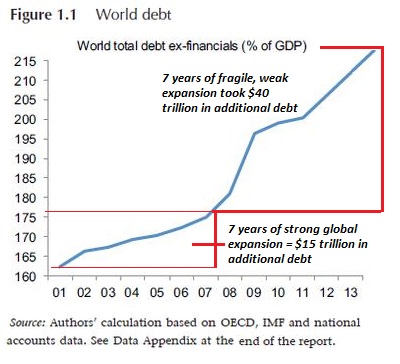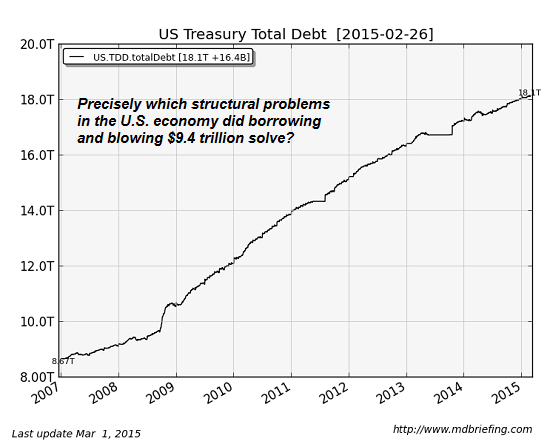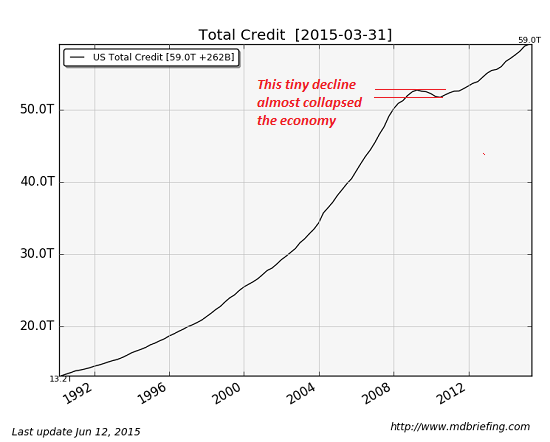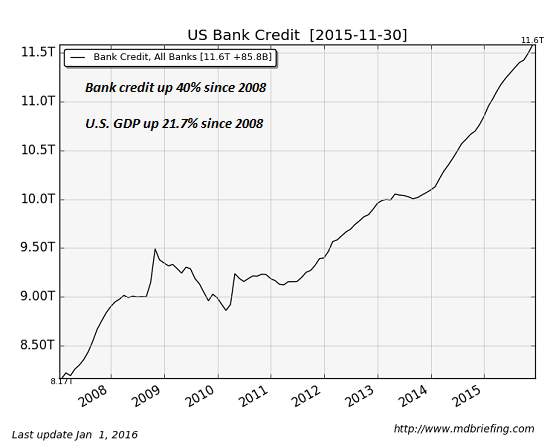2016 Theme #4: The End-Game of Debt-Fueled "Growth"
January 7, 2016
This week I am addressing themes I see playing out in 2016.
A number of systemic, structural forces are intersecting in 2016. One is the end-game of debt-fueled "growth."
We can summarize the official "solution" to the Global Financial Meltdown of 2008 in one line: borrow and blow trillions--of yen, yuan, dollars, euros, reals, you name it.
The goal of borrowing and blowing trillions was to re-invigorate "growth"-- any kind of "growth," no matter how wasteful, unproductive or even counter-productive it might be: wars, nation-building, ghost cities, needless MRIs, useless college diplomas, bridge to nowhere--anything the borrowed money was squandered on counts as "growth" in the Keynesian status quo.
Unsurprisingly, this strategy yields diminishing returns as the negative returns on all this debt-fueled spending piles up. While the yield on the "investment" is either negative or only fleetingly positive, the interest due on the debt is forever. That's the source of diminishing returns in a nutshell.
The diminishing returns on additional debt is clearly visible in these charts.
Global debt has soared but this massive stimulus has yielded subpar "growth" (and the final costs of all the astounding mal-investment have yet to be totaled):

Has borrowing and blowing $9 trillion solved any structural problem in the U.S. economy? No.

While total credit in the U.S. has exploded, GDP (a measure of actual output) has under-performed for years. The tiny decline of credit in the 2008-09 financial meltdown almost collapsed the global economy. The strategy of borrowing and blowing trillions has backed the global economy into a corner: expand debt or die.

While U.S. bank credit has expanded by 40%, GDP has risen 21.7%--roughly half the rate of credit expansion. This is diminishing returns on a vast scale.

It's requiring more borrowed yen/yuan/dollars/euros just to keep the global economy from collapsing in a heap of impaired debt. The costs of waste, fraud and mal-investment are finally coming home to roost, and while near-zero interest rates serve to mask the future costs, near-zero rates cannot stem the rising tide of mal-investment.
Rather, near-zero rates have fueled mal-investment, waste and unproductive spending. The diminishing returns on that strategy of "growth" are inescapable.
My new book is #7 in Amazon's Kindle ebooks > Business & Money > International Economics: A Radically Beneficial World: Automation, Technology and Creating Jobs for All. The Kindle edition is $$9.95 and the print edition is currently discounted to $21.60.
NOTE: Contributions/subscriptions are acknowledged in the order received. Your name and email remain confidential and will not be given to any other individual, company or agency.
|
Thank you, Charles M. ($120), for your outrageously generous contribution to this site -- I am greatly honored by your steadfast support and readership. |
Thank you, John H. ($50), for your superbly generous contribution to this site -- I am greatly honored by your steadfast support and readership. |

Discover why Iím looking to retire in a SE Asia luxury resort for $1,200/month.